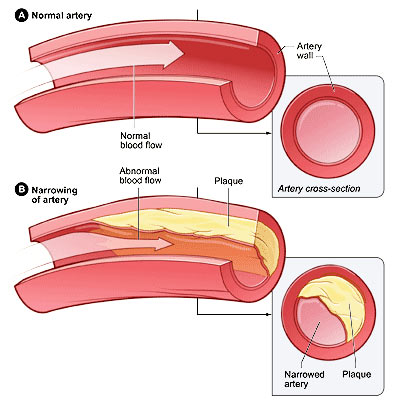
Coronary Artery Disease
What is coronary artery disease (CAD)?
Coronary artery disease (CAD), also called coronary heart disease, or heart disease is the most common type of heart disease and affects millions of Americans. It is a serious condition and the leading cause of heart attacks and death in the United States in both men and women.

What are the signs and symptoms of coronary artery disease (CAD)?
A person with coronary artery disease (CAD) can experience one or more symptoms. The symptoms and pain associated with coronary artery disease can be mild and intermittent but then may become more intense and constant.
- Chest pain (angina): During episodes of angina, you may feel chest pressure, discomfort, heaviness, squeezing, aching, or burning. The pain may also occur in your shoulders, arms, neck, jaw, or back. There are 3 types of angina:
- Stable angina is the most common type. It happens when the heart is working harder than usual. Stable angina has a regular pattern. Rest and medicines usually help.
- Unstable angina is the most dangerous. It does not follow a pattern and can happen without physical exertion. It does not go away with rest or medicine. It is a sign that you could have a heart attack soon.
- Variant angina is rare. It happens when you are resting. Medicines can help.
- Shortness of Breath: You may experience difficult or uncomfortable breathing or feeling like you are not getting enough air.
- Heart Attack: Some people experience signs and symptoms of a heart attack hours, days, and even weeks in advance. The symptoms and severity can vary greatly depending on the individual.
- Chest pain or discomfort: The most common presentation of a heart attack is chest pain or discomfort, which can feel like pressure, tightness, aching, burning, or fullness. Patients have described this sensation as feeling like an elephant is sitting on their chest.
- Shortness of breath: Having shortness of breath or labored breathing, especially while resting can be a sign of heart attack or heart failure (heart function is abnormal).
- Discomfort in other areas of the upper body: Symptoms can include pain or discomfort in one or both arms, the back, neck, jaw, or stomach.
- Other symptoms: Feeling dizzy or lightheaded, nausea, sweating, unexplained/excessive fatigue, panic attack, or unexplained feeling of anxiety.
- Atypical symptoms: Some individuals may not have chest pain/discomfort and can present with unusual signs and symptoms which include upper abdominal pain, indigestion, stabbing pain with coughing and breathing, irregular heartbeat, and difficulty breathing. This is most common in older adults, women, and diabetic patients.
Men vs Women: As with men, women’s most common heart attack symptom is chest pain, but women are somewhat more likely than men to experience some of the other common symptoms, particularly flu-like symptoms, unusual fatigue, heartburn, shortness of breath, nausea/vomiting and back or jaw pain. According to the American Heart Association, heart disease is the No. 1 killer of American women, causing 1 in 3 female deaths and claiming more lives than all forms of cancer.
If you suspect you're having a heart attack, immediately call 911 and get to the nearest hospital right away!
What are the risk factors for coronary artery disease (CAD)?
- Age: Getting older increases your risk of coronary artery disease due to damaged and narrowed arteries which restrict blood supply to the heart.
- Gender: Heart disease is the leading cause of death for both men AND women in the United States. Generally, men are at greater risk of coronary artery disease and the risk for women increases after menopause. What was often thought of as a “man’s disease”, heart disease, continues to be a woman’s greatest health threat.
- Family history: A family history of heart disease is associated with a higher risk of coronary artery disease, especially if a close relative developed heart disease at an early age. Your risk is highest if your father or a brother was diagnosed with heart disease before age 55 or if your mother or a sister developed it before age 65.
- Smoking: People who smoke have a significantly increased risk of heart disease. Exposing others to your secondhand smoke also increases their risk of coronary artery disease.
- High blood pressure: Uncontrolled high blood pressure can result in hardening and thickening of your arteries, narrowing the channel through which blood can flow.
- High blood cholesterol levels: High levels of cholesterol in your blood can increase your risk of the formation of plaque and atherosclerosis. High cholesterol can be caused by a high level of low-density lipoprotein (LDL) cholesterol, known as the "bad" cholesterol. A low level of high-density lipoprotein (HDL) cholesterol, known as the "good" cholesterol, can also contribute to the development of atherosclerosis.
- Diabetes: Diabetes is associated with an increased risk of coronary artery disease. Type 2 diabetes and coronary artery disease share similar risk factors, such as obesity and high blood pressure.
- Overweight or obesity: Excess weight typically worsens other risk factors and can increase the risk of developing atherosclerosis and coronary artery disease.
- Physical inactivity: Lack of exercise also is associated with coronary artery disease and its risk factors.
- High stress: Unrelieved stress in your life may damage your arteries as well as worsen other risk factors for coronary artery disease.
Unhealthy diet: Eating too much food that has high amounts of saturated fat, trans fat, salt and sugar can increase your risk of coronary artery disease.
- Sleep apnea: This disorder causes you to repeatedly stop and start breathing while you are sleeping. Sudden drops in blood oxygen levels that occur during sleep apnea increase blood pressure and strain the cardiovascular system, possibly leading to coronary artery disease.
- High sensitivity C-reactive protein: High sensitivity C-reactive protein (hs-CRP) is a normal protein that appears in higher amounts when there is inflammation somewhere in your body. High hs-CRP levels may be a risk factor for heart disease because it is thought that as coronary arteries narrow, you will have more hs-CRP in your blood.
- High triglycerides: This is a type of fat (lipid) in your blood. High levels may raise the risk of coronary artery disease, especially for women.
- Homocysteine: Homocysteine is an amino acid your body uses to make protein and to build and maintain tissue however high levels of homocysteine may increase your risk of coronary artery disease.
- Preeclampsia: This condition that can develop in women during pregnancy causes high blood pressure and a higher amount of protein in the urine. It can lead to a higher risk of heart disease later in life.
- Alcohol use: Heavy alcohol use can lead to heart muscle damage and worsen other risk factors of coronary artery disease.
- Autoimmune diseases: Conditions such as rheumatoid arthritis and lupus (and other inflammatory rheumatologic conditions) have an increased risk of atherosclerosis.
How is coronary artery disease (CAD) diagnosed?
A diagnosis of coronary artery disease begins with your doctor asking about your symptoms, your medical and family history, and your risk factors. There are several diagnostic tests that can be performed to diagnose coronary artery disease (CAD). These tests help your doctor learn the cause of your symptoms, the extent of your coronary artery disease (CAD), its effect on your heart, and the best treatment for you.
What are the complications of coronary artery disease (CAD)?
Heart Center Quick Links
